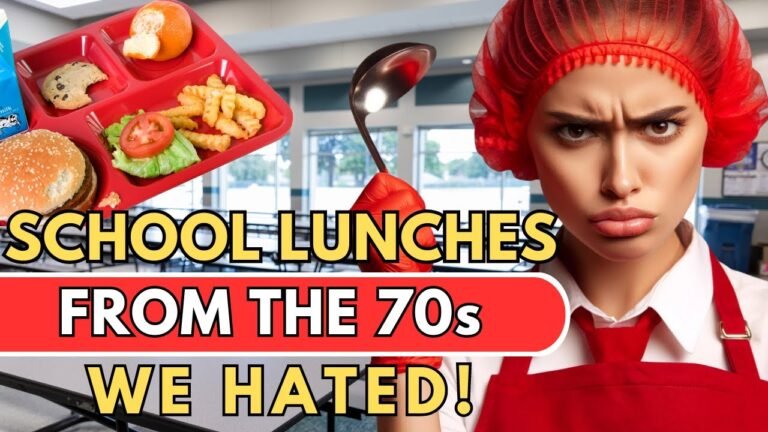6 Remembering School Lunches of the 70s: A Nostalgic Trip Down Cafeteria Lane

If you went to school in the 1970s, you probably have strong memories of the lunches served in the cafeteria.
These meals can bring back a lot of nostalgia, whether you loved them or couldn’t stand them. Remembering these school lunches offers a fun glimpse into daily life and the culture of the time.
In this article, we’ll take a trip down memory lane to revisit some of the most iconic school lunches from the 70s.
From the good to the not-so-good, these meals were a big part of growing up and have left a lasting impression on many people.
1) Fish Sticks and Tartar Sauce
Back in the 70s, fish sticks were a staple in school lunches.
They were often served once a week, usually on Fridays.
You’d find these golden, crispy breaded fish sticks on your tray, waiting to be dipped into tartar sauce.
The tartar sauce was usually a creamy mixture of mayo and pickles.
Some schools made their own, but most used store-bought jars.
The combination of the crisp fish sticks and tangy tartar sauce made for a savory treat.
Sometimes, the fish sticks weren’t perfectly crispy, but kids didn’t mind much.
The excitement of easily dunkable food in a creamy dip was enough to make it a weekly favorite.
The fish sticks were often accompanied by sides like fries or peas, making for a simple but satisfying meal.
If you were lucky, you might even get a lemon wedge to squeeze over your fish sticks for a bit of extra flavor.
This small touch added a fresh burst to the meal.
Fish stick day was something many kids looked forward to, marking it as a memorable part of 70s school lunches.
2) Pizza Squares with Corn
Back in the 70s, school lunch wasn’t complete without those iconic pizza squares.
They came in a big rectangle shape, topped with gooey cheese and a tangy tomato sauce.
You’d often find these pizza squares served alongside a scoop of corn.
The sweet corn paired well with the savory pizza.
It might sound odd today, but it was a classic combo.
The pizza had a thick, doughy crust that was almost bread-like.
Kids loved biting into it and finding that burst of cheese flavor.
It’s one of those flavors that brings back memories for many.
Interestingly, the pizza recipe was pretty simple.
It used basic ingredients like flour, water, yeast, and lots of cheese.
Despite its simplicity, it left a lasting impression.
While pizza squares and corn may not be the trendiest meal now, they were a staple of 70s school lunches.
It’s fun to look back on those days and remember how this unlikely pairing was a favorite among students.
3) Peanut Butter and Jelly Sandwich
In the 1970s, a classic peanut butter and jelly sandwich was a staple in many school lunches.
You’d find them in almost every lunchbox.
They were simple and easy for parents to make, yet delicious enough that kids rarely complained.
Whether your favorite was creamy peanut butter with grape jelly or chunky peanut butter with strawberry jam, this sandwich never disappointed.
Some schools even offered them as a lunch option on days when you just didn’t feel like eating what was on the menu.
Making a PB&J was straightforward.
Grab two slices of white or whole wheat bread.
Spread a generous layer of peanut butter on one slice and jelly on the other.
Put them together, and you’re good to go.
Kids loved the mix of sweet and salty flavors.
The sandwiches were also filling, giving you the energy needed to get through the rest of the school day.
They were affordable, too, which made them a go-to choice for many families.
It’s no wonder why the peanut butter and jelly sandwich remains a nostalgic favorite for those who grew up in the ’70s.
4) Chicken Fried Steak
Chicken fried steak was a big favorite in school lunches during the 70s.
This dish, covered in crispy breading and usually smothered in gravy, brought comfort to many students.
You’d often find it served with mashed potatoes on the side.
The creamy potatoes and savory gravy made for a tasty combination.
Usually, there were canned green beans or corn alongside the main dish.
While the vegetables might not have been the star, they were part of the meal’s charm.
Chicken fried steak days were highly anticipated.
It was one of those meals you looked forward to, breaking up the monotony of everyday lunch options.
The school cafeteria staff worked hard to keep students fed, and dishes like chicken fried steak showed they cared.
It’s easy to see why many people remember it fondly.
5) Chocolate Pudding Cups
Chocolate pudding cups were a big hit in the 1970s.
These little treats were smooth, creamy, and perfectly portioned.
You could easily toss one into your lunch box without worrying about it spoiling.
Hunt’s Snack Pack puddings were especially popular.
They came in small metal cans with a ring pull-top.
This type of packaging felt modern and fun for the time.
Opening a pudding cup was an adventure.
You’d pull back the ring and get that satisfying pop.
The lid had a sharp edge, so you had to be careful, but it was worth it for the delicious chocolate inside.
Swiss Miss was another brand you might remember.
Their pudding cups were usually found in the dairy section, making them a creamy option for your lunch.
These pudding cups were a sweet end to your school lunch.
Whether you enjoyed them in the cafeteria or on the playground, they were a tasty highlight of the 1970s lunch experience.
6) Sloppy Joes
Remember the taste of Sloppy Joes in the school cafeteria? They were a staple of the 70s school lunches.
The hearty flavor of ground beef mixed with tomato sauce and spices hit the spot.
The recipe was simple.
Ground beef was browned in a large skillet.
Often, onions and garlic were added for extra flavor.
Then, it was time for the magic ingredients like ketchup, tomato paste, a splash of vinegar, and a bit of brown sugar.
Cooks would let this mixture simmer, thickening up into a rich, tangy mess.
The aroma always filled the cafeteria, making your stomach growl.
The final step was dishing up the meat onto soft buns.
Sloppy Joes were messy, no doubt.
Part of the fun was trying to keep the filling from dripping out as you took a big bite.
It wasn’t just a meal; it was an experience.
Some schools would sometimes add a twist, like using ground turkey.
No matter the variation, Sloppy Joes remained a favorite, bringing comfort and satisfaction.
You could always count on them for a tasty and filling lunch.
Nostalgic Ambiance
School lunches in the 70s weren’t just about the food.
The setting and social aspects added to the experience, shaping lasting memories.
Cafeteria Decor and Set-Up
Your school cafeteria likely had a simple, functional design. Plastic trays in muted colors, often beige or green, were the norm.
Long, communal tables with attached benches filled the space.
The walls might have been decorated with educational posters, school spirit banners, and student artwork.
This not only served as decoration but also created a sense of community.
The lighting was fluorescent, casting a cool, somewhat harsh light over everything.
Floors were typically tiled, making it easy to clean but noisy when filled with chattering students.
Lunchroom Traditions and Social Dynamics
Lunchtime was more than eating; it was a social event.
You probably had your favorite spot to sit, often with the same group of friends.
The cafeteria was divided into sections, unofficially claimed by different groups—athletes, band members, and various other social circles.
Special events like “Pizza Fridays” or “Ice Cream Wednesdays” were highlights.
Trading food was common; you might exchange your apple for a friend’s cookie.
Despite occasional food fights and the bustling noise, these moments fostered camaraderie and friendship.
The Evolution of School Lunches
School lunches have changed a lot over the years, influenced by new nutritional standards and government policies.
This section dives into these shifts and their results.
Changes in Nutritional Standards
In the early years, school lunches were simple and often lacked variety.
By the 1960s, more diverse options like pizza and chili became common.
School meals started to include more ethnic foods, adding variety to students’ diets.
The 1970s saw an emphasis on improving the nutritional value of school lunches.
Some schools tried to focus on balanced meals, though options like burgers and fries were still very popular.
The key was to balance taste with nutrition.
More recently, nutritional standards have become stricter.
Schools must provide meals with more fruits and vegetables, whole grains, and lean proteins.
Sugary drinks and high-fat foods have been reduced.
These changes aim to combat childhood obesity and improve overall health.
Impact of Government Policies
Government policies have significantly shaped school lunch programs.
During the Great Depression, the USDA created guidelines to help schools use surplus food.
This led to the early structured school lunch programs.
In the 1940s, the National School Lunch Act was passed, setting the stage for federal support of school lunches.
This act aimed to provide nutritious meals to all students, regardless of their economic background.
In the 2010s, Michelle Obama’s Healthy Hunger-Free Kids Act introduced stricter nutritional standards.
This act required schools to serve more nutritious meals and limit unhealthy options.
These policies continue to influence what kids eat at school today.
Government policies have played a crucial role in shaping school lunches, from the Depression era to modern times.
New standards continue to evolve, aiming to improve the health and well-being of students across the country.
Culinary Trends of the 70s
The 1970s brought a fascinating blend of convenience foods and colorful culinary creativity.
You’ll find that this decade helped shape many of the favorite dishes remembered today.
Popular Food Items and Brands
In the 70s, convenience played a big role in school lunches. Canned ravioli, fish sticks, and hot dogs were common.
These quick, easy options were loved by students and school cafeterias alike. Jell-O salads were another trend, often filled with fruits or vegetables.
Watergate salad was famous, blending pistachio pudding, pineapple, marshmallows, and Cool Whip.
For dessert, you might have enjoyed Wacky Cake, made without eggs or dairy.
It used simple, budget-friendly ingredients, making it a popular choice for families and schools.
Brands like Betty Crocker, Kraft, and Campbell’s Soup became household names.
Packaged foods, including macaroni and cheese and TV dinners, became staples.
These foods made meal preparation quick and easy, fitting the busy lifestyle of the 70s.
Influence of TV and Pop Culture
TV and pop culture had a huge impact on the food trends of the 70s.
Cooking shows gained popularity, showcasing meals that could be prepared at home. Julia Child and The Galloping Gourmet influenced many to try new dishes.
Commercials also played a big role, promoting foods like Tang, a powdered drink mix that promised to be what astronauts drank, and Funny Face drink mixes. Processed snacks like Pop-Tarts and Twinkies gained fame through catchy ads.
Movies and TV shows often featured characters enjoying these foods, which made them seem even more appealing.
This led to a cycle where foods seen on TV became popular in real life, and then back into more shows and commercials.

